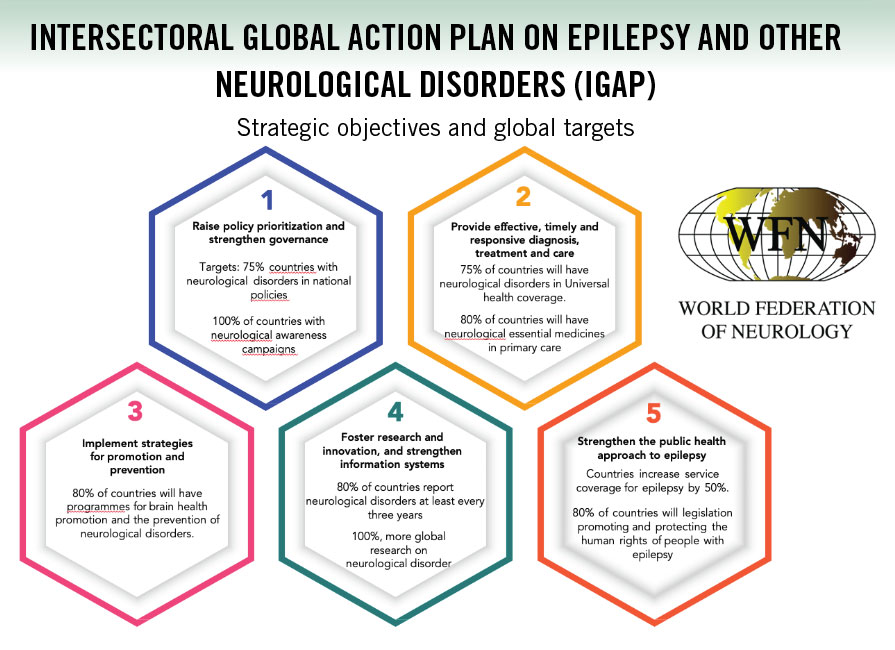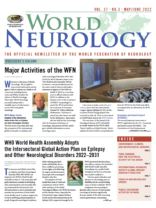By Kimberly Karlshoej, WFN Strategy and Program Director, and Wolfgang Grisold

Kimberly Karlshoej
The Intersectoral Global Action Plan on Epilepsy and Other Neurological Disorders 2022–2031 (IGAP) was adopted at the WHO’s World Health Assembly on May 27. This action plan will guide numerous countries in developing their national policies and eventually offer up a framework for best practices that will ensure better access to treatment and prioritize the promotion of brain health across the life course. It seeks to support the recovery, well-being, and participation of people living with neurological conditions while reducing associated deaths and disability due to these conditions, promoting human rights, and addressing the stigma and discrimination that people with neurological disorders often face.
The adoption of IGAP results from years of work and consultations with the WFN, other members of the Global Neurological Alliance, the WHO Secretariat and the Member States. Especially the International League Against Epilepsy (ILAE) and the International Bureau for Epilepsy (IBE), supported strongly by the WFN and several Member States, were able to convince the November 2020 World Health Assembly that epilepsy was a public health emergency and that an action plan was needed to address it.

WFN diagram iIlustrating the strategic objectives of IGAP.
Nervous system disorders and diseases are the leading cause of disability and the second-leading cause of death worldwide. WHO emphasizes that neurological disorders affect one out of three people. Neurological disorders significantly decrease quality of life while increasing costs for governments, communities, families, and individuals and cause sustained losses of productivity for economies. That’s why the global action plan is so vital. It sets strategic goals and reachable targets that will encourage countries to prioritize neurological diseases in their public health agendas.
The WFN is fully committed to the implementation of IGAP. Work relating to IGAP is ongoing, for example in improving neurology specialty, subspecialty, and health care worker training through WFN Training Centers, Department Visits, E-Learning Days, and the development of a Core Curriculum in Neurology. The Neurological Needs Registry will provide relevant comparative information to both the WHO, Member States, and WFN Member Societies. The WFN Trustees have nascent plans to implement advocacy training so that the WFN can help build the capacity of its Member Societies to reach, advise, and lobby their governments so that neurology is included in relevant ways in national policies. WFN will continue its public awareness campaigns such as World Brain Day, which has the theme of “Brain Health for All” this year. Finally, the WFN will continue to provide expert technical assistance to WHO. Over the next 10 years of IGAP, the WFN expects that the actions and policies put in place will contribute to saving lives and significantly reducing disability from neurological disorders worldwide.•
IGAP Summarized
The Intersectoral Global Action Plan on Epilepsy and Other Neurological Disorders 2022 – 2031 (IGAP) aims to improve access to care and treatment for people living with neurological disorders while preventing new cases and promoting brain health and development across the life course. It seeks to support the recovery, well-being, and participation of people living with neurological conditions while reducing associated mortality, morbidity, and disability, promoting human rights, and addressing stigma and discrimination through interdisciplinary and intersectoral approaches.
Vision
The vision of the intersectoral global action plan on epilepsy and other neurological disorders 2022–2031 is a world in which:
- brain health is valued, promoted, and protected across the life course
- neurological disorders are prevented, diagnosed, and treated, and premature mortality and morbidity are avoided
- people affected by neurological disorders and their carers attain the highest possible level of health, with equal rights, opportunities, respect, and autonomy.
Goal
The goal of the intersectoral global action plan on epilepsy and other neurological disorders 2022–2031 is to reduce the stigma, impact, and burden of neurological disorders, including their associated mortality, morbidity, and disability, and to improve the quality of life of people with neurological disorders, their carers, and families.
The intersectoral global action plan on epilepsy and other neurological disorders 2022–2031 has the following strategic objectives:
- raise policy prioritization and strengthen governance
- provide effective, timely and responsive diagnosis, treatment, and care
- implement strategies for promotion and prevention
- foster research and innovation and strengthen information systems
- strengthen the public health approach to epilepsy.
Strategic Objective 1
Raise policy prioritization and strengthen governance
Global target 1.1
75% of countries will have adapted or updated existing national policies, strategies, plans, or frameworks to include neurological disorders by 2031.
Global target 1.2
100% of countries will have at least one functioning awareness campaign or advocacy program for neurological disorders by 2031.
Strategic Objective 2
Provide effective, timely, and responsive diagnosis, treatment, and care
Global target 2.1
75% of countries will have included neurological disorders in the UHC benefits package by 2031.
Global target 2.2
80% of countries will provide the essential medicines and basic technologies required to manage neurological disorders in primary care by 2031.
Strategic Objective 3
Implement strategies for promotion and prevention
Global target 3.1
80% of countries will have at least one functioning intersectoral program for brain health promotion and the prevention of neurological disorders across the life course by 2031.
Global target 3.2
The global targets relevant for prevention of neurological disorders are achieved, as defined in:
- the NCD-GAP
- defeating meningitis by 2030: a global road map
- every newborn: an action plan to end preventable deaths.
Strategic Objective 4
Foster research and innovation and strengthen information systems
Global target 4.1
80% of countries routinely collect and report on a core set of indicators for neurological disorders through their national health data and information systems at least every three years by 2031.
Global target 4.2
The output of global research on neurological disorders doubles by 2031.
Strategic Objective 5
Strengthen the public health approach to epilepsy
Global target 5.1
By 2031, countries will have increased service coverage for epilepsy by 50% from the current coverage in 2021.
Global target 5.2
80% of countries will have developed or updated their legislation with a view to promoting and protecting the human rights of people with epilepsy by 2031. •
Kimberly Karlshoej is strategy and program director for the WFN.
